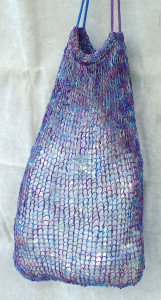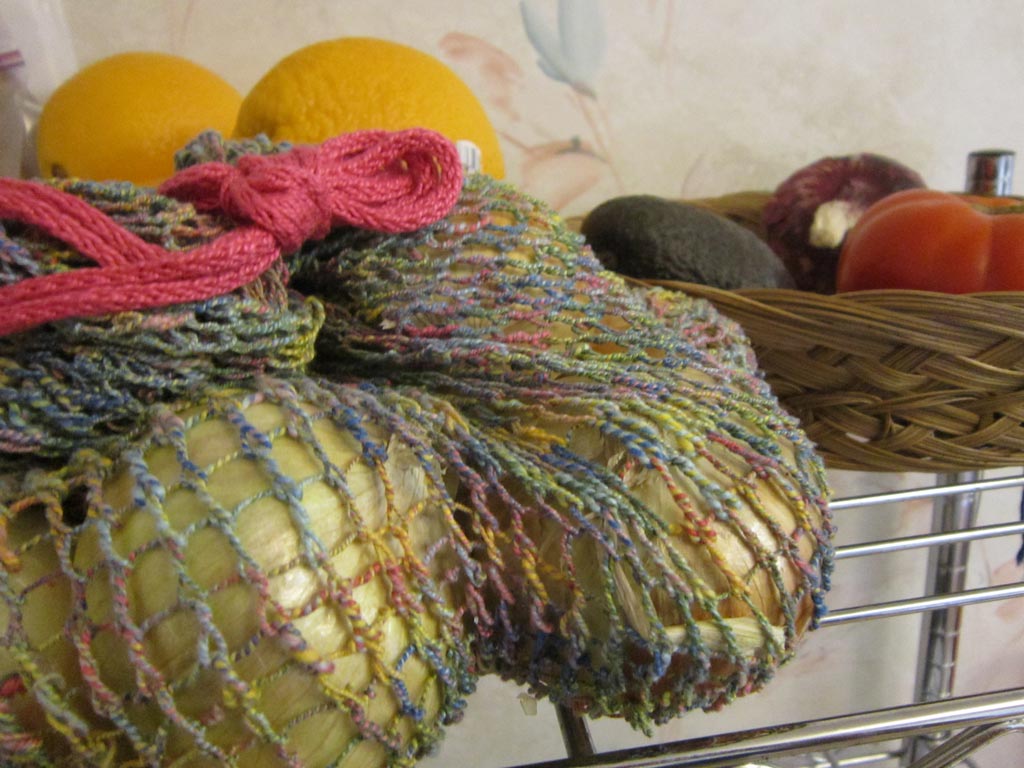I call the method used to make this stitch “cross looped”. It’s lace-like because of it’s openness, but not technically lace. I guess we will refer to it as non-lace lace.
How are you coming along on this month’s KAL for the Market Bag? Sorry I have been more quiet than usual — Been tied up with things to help John (my man-friend) through his eye surgeries. He is doing great now and we are seeing the light at the end of the tunnel, so to speak.
But anyway, back to the Market Bag KAL. I wanted to share some comments and technique pointers, whether you are knitting the bag now or might be later on.
Netting Similar to Filet Lace
As I explained earlier in the month, this is not technically lace. There are no yarn overs, yet it results in an openwork stitch that looks like it might be lace.
In fact, it rather resembles a netting similar to the filet lace we knit earlier this year for the I Heart Filet Lace scarf, don’t you think?
The double-height elongated twisted is the reason for this open look. It also contributes to vertical strength, which is obviously a good feature in a bag. SuzyStitches on Ravelry commented: “It appears to be a very strong bag, the crossed loop stitch looks much like chain link fence to me.”
Self-Joining Tubular Casing
The bag begins at the stop for the drawstring casing. You cast on double the amount of stitches that will eventually be used for the bag.
The technique of using alternating slipped-stitches in the pattern for making the tubular casing results in a 2-sided fabric.
The self-joining step avoids seaming, which instead is simply done with k2tog stitches all around.
Eyelet Openings in the Casing for the Drawstrings
On row 6 while doing the Tubular Casing, there is a somewhat complicated-looking set of instructions. Basically you are just making simple eyelets (i.e. yo, k2tog) through which the drawstring handles can later be threaded. But there are extra steps in between because of stitches that need to be slipped and exchanged positions to maintain the integrity of the 2-sided fabric. Just trust me and do what it says.
Closing the Bag Bottom with 3-Needle Bind Off
The bottom of the bag is secured with the sturdy 3-needle bind off technique. It’s a great technique to provide a sturdy join without sewing.
Drawstring Handles
The pattern includes instructions to make handles using the I-cord technique. In previous KAL’s we made a short length of I-cord as the stem in the Bits of Lace Oak Leaf and the stem of the Little Beaded Pumpkin. But for this bag, you have to knit a LOT of I-cord. If it gets too boring, you can always use some pre-made cords or heavy string, lol.




 HeartStrings FiberArts
HeartStrings FiberArts Knitting Bits of Lace on Facebook
Knitting Bits of Lace on Facebook Ravelry Store
Ravelry Store